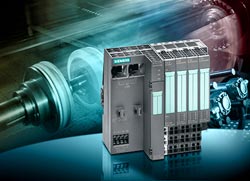Save energy with Profienergy during production breaks

The power module specifically switches off individual inputs and outputs of the Simatic ET 200S High Feature I/O system and disconnects their connected loads from the power supply. With the new function blocks it is possible to implement energy management of entire plant sections.
They are based on the new Profienergy profile of the Profibus International (PI) and the new I device (Intelligent Device) Profinet functionality that permits I/O communication between one CPU and other higher-level or central controllers. These function blocks take into consideration any automation structures with Simatic CPU 315-2 PN/DP, CPU 317-2 PN/DP and CPU 319-3 PN/DP controllers and Simatic ET 200S and ET 200pro distributed I/O systems with CPU functionality.
The vendor-independent and device-independent Profienergy profile standardized according to the PI enables individual devices or even entire sections of a production plant to be shut down without external hardware using a single controller via Profinet communication. Loads are switched off during production breaks in a coordinated fashion from a central location while other automation components are able to remain in operation, for example for safety-related tasks. At the end of the break the loads are then switched on again in a coordinated manner.
The Siemens Industry Sector (Erlangen, Germany) is the worldwide leading supplier of environmentally friendly production, transportation, building and lighting technologies. With integrated automation technologies and comprehensive industry-specific solutions, Siemens increases the productivity, efficiency and flexibility of its customers in the fields of industry and infrastructure. The Sector consists of six divisions: Building Technologies, Drive Technologies, Industry Automation, Industry Solutions, Mobility and Osram. With around 207,000 employees worldwide (September 30), Siemens Industry achieved in fiscal year 2009 total sales of approximately €35 billion.
The Siemens Industry Automation Division (Nuremberg, Germany) is a worldwide leader in the fields of automation systems, industrial controls and industrial software. Its portfolio ranges from standard products for the manufacturing and process industries to solutions for whole industrial sectors that encompass the automation of entire automobile production facilities and chemical plants. As a leading software supplier, Industry Automation optimizes the entire value added chain of manufacturers – from product design and development to production, sales and a wide range of maintenance services. With around 39,000 employees worldwide (September 30), Siemens Industry Automation achieved sales of €7.0 billion in fiscal year 2009.
Reference Number: IIA2010032230e
Media Contact
All latest news from the category: Power and Electrical Engineering
This topic covers issues related to energy generation, conversion, transportation and consumption and how the industry is addressing the challenge of energy efficiency in general.
innovations-report provides in-depth and informative reports and articles on subjects ranging from wind energy, fuel cell technology, solar energy, geothermal energy, petroleum, gas, nuclear engineering, alternative energy and energy efficiency to fusion, hydrogen and superconductor technologies.
Newest articles

High-energy-density aqueous battery based on halogen multi-electron transfer
Traditional non-aqueous lithium-ion batteries have a high energy density, but their safety is compromised due to the flammable organic electrolytes they utilize. Aqueous batteries use water as the solvent for…

First-ever combined heart pump and pig kidney transplant
…gives new hope to patient with terminal illness. Surgeons at NYU Langone Health performed the first-ever combined mechanical heart pump and gene-edited pig kidney transplant surgery in a 54-year-old woman…

Biophysics: Testing how well biomarkers work
LMU researchers have developed a method to determine how reliably target proteins can be labeled using super-resolution fluorescence microscopy. Modern microscopy techniques make it possible to examine the inner workings…





















